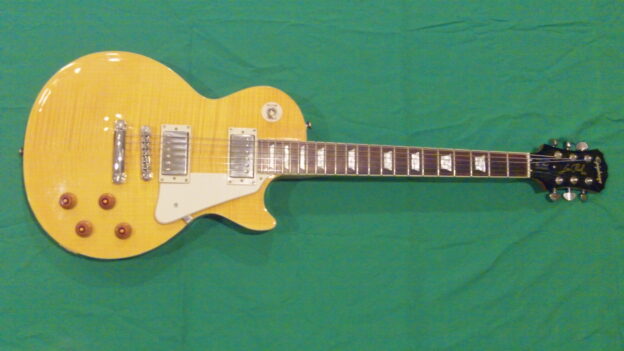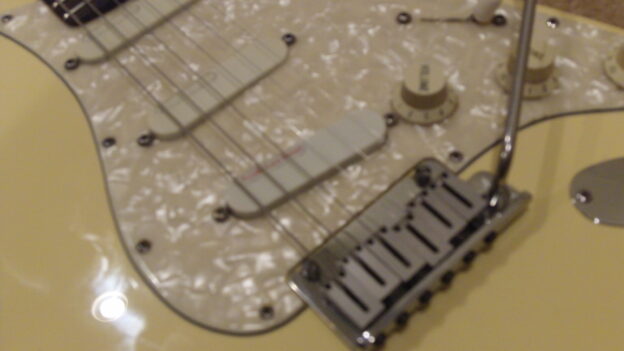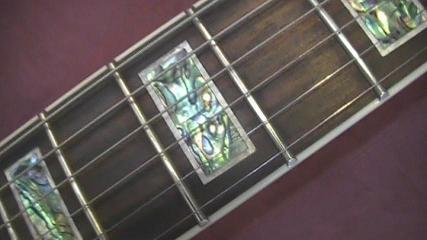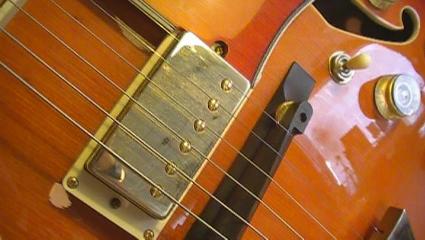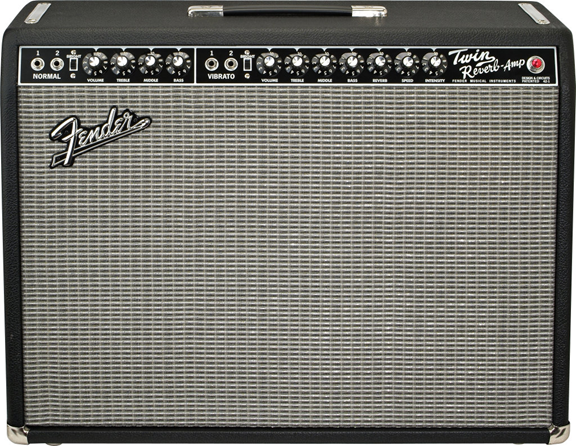By Chad Crawford, PMI Guitar Instructor
If you are in my age range or better then you may remember IT. IT was a millennia-old creepy space alien featured in the 1986 Stephen King novel of the same name, and a TV miniseries in 1990. IT manifested itself to the neighborhood children in the form of a circus clown. IT would appear in a benevolent clown form and woo the neighborhood children with laughter and promises of balloons and parties, and then when he had their confidence would morph into a scary clown and steal them away to a creepy underground bunker.
In the novel and film the surviving neighborhood kids grew up and came home to band together and defeat IT once and for all … or so they thought. The fact is, in teaching guitar to beginners and up for some years now, I have found that IT is hanging around my studio. He pops up all over the place. For example, when providing feedback on technique refinements I often hear responses such as, “I’m trying, but IT (“my hand”) wants to do it this way,” or “IT wants to tense up when I try to move that fast,”, or “IT (the pick) shifts around when I try to hold IT this way.” “IT (my thumb) wants to hook ITself over the top of the neck.” “IT (my pinkie) wants to curl up into a popcorn shrimp when I make a fifth chord.”
Indeed. Creepy IT seems to be the number one barrier to progress for many students of guitar. This need not be so, because the fact is … there is no IT. There is only YOU. YOU are the Scary Guitar Clown. It is YOU who is permitting excess tension, allowing the fingers to fly and flop around chaotically, plowing the pick through the strings like a bulldozer, allowing mental focus to drift, and generally making the hands and fingers wrestle against the strings rather then dance with them.
If you like your IT you can keep IT! However, if you want maximum results in the shortest possible time then you will have to deal IT a crushing death blow sooner rather than later. The first step in conquering IT is to acknowledge that IT is YOU. If your fingers are doing anything at all other than totally relaxing, then YOU are doing it. Apart from direct physical manipulation by someone or something other than you, your fingers can not do anything except exactly what your brain tells them to do. Pinkies do not curl up into a tight ball on their own. Likewise, if you are locking up your wrist and clamping too firmly on the pick during rhythm strokes, it is YOU tightening up the forearm muscles that control the wrist. YOU are doing that, not IT! So take responsibility and avoid passing the blame to IT!
Now let us discuss for a minute why IT gets the blame for so much technique chaos. We come from the factory equipped with several levels of control over the muscular systems. Level 1 is the autopilot mode. The heart, for example, will continue to beat at the set tempo regardless of our consciousness of it or efforts to manipulate it through focused attention. Level 2 is the autopilot with manual override. The eyelids are a good example of this one. When we are awake they close and open without any conscious attention, and when we sleep they remain closed. However, we may at any time take full control of them, either blinking, holding open, or holding closed as we prefer, until we release them back into the control of the autopilot mode. Then we have the skeletal muscles on Level 3. They run mostly in manual mode with autopilot override for special circumstances, such as the knee jerk reaction when the leg responds to a strike to the knee joint.
Then we have the fingers. How do we label the control mode of the fingers? I think most entry level guitarists would say something like, “Manual mode until I try to play guitar, then Scary Guitar Clown mode,” by which they mean that it seems impossible to fully control the fingers when trying to manipulate them individually, when IT appears to take over. Is this really true? It is partially true and partially not true. The fingers run on a mix of all the above modes, but mostly on manual control. If you don’t think they have an autopilot override, try putting them on a hot stove burner and you will see how quick they go into autopilot override.
So how does this examination help us to defeat the Scary Clown Mode? We must understand four important things about the control of the fingers:
(1) The default control mode of the fingers is a hybrid of manual control of the fingers as a group, with autopilot control of the other fingers when trying to use one independently. To illustrate, put the tips of all four fingers downward facing on the edge of a table and then use the other hand to curl the pinky until the tip touches the palm. It is quite easy, with no strain on the knuckles, muscles, or skin. Now try to do that same test with your fingers free from outside constraints, using only the control offered by your mind. You will observe that the ring finger follows along with the pinky, no matter how hard you try to separate the two. Why does this happen? Mechanically the two are completely independent. It is the default programming of the brain making the ring finger follow the pinky. The default program is to use the fingers as a group. This is great for grasping things firmly, but it is totally contrary to what we need to do as guitarists. This is the deadly IT of which we speak, and the one we must overcome in order to develop a great command over guitar technique.
(2) In addition to the limited degree of manual independent control we have over the fingers by default, we can cultivate greater individual finger control through focused repetition of specific movements. This is why scale practice should always be near the top of your guitar practice priorities. Scale practice is not simply a tool to remember note placement. Among other things, if done correctly it is the most powerful technique improvement tool available. With enough practice we can not only cultivate finger independence, but we can actually reprogram the autopilot portion of our finger control so that it does new things in autopilot mode, such as play through scales accurately and efficiently. This is the secret of mastering guitar technique. It is important to note here that we are reprogramming the autopilot every time we practice, regardless of whether we are practicing great technique, good technique, or slop. This is why it is important to pay attention to the details while practicing scales!
(3) Regarding the pick hand, it is very important to understand that you have already spent many years cultivating an alternate autopilot program that takes over when you attempt to exercise fine control over the pick hand – writing. Writing is similar to picking, but not the same, so when you allow the writing autopilot to take over when you go to pick, you will have poor control over the pick.
(4) Ultimately, we DO in fact have a great degree of control over individual fingers, but we must consciously choose to exert this control in defiance of the default programs. For example, I often see a tightly curled pinky when making fifth chords (power chords), and I always advise that this creates unnecessary tension, which further causes unnecessary levels of finger pressure and undue difficulties in changing from one fretboard location to another. I then advise to manual override the pinky popcorn shrimp of death while making the fifth chords. It is always a struggle at first, but I have yet to observe a student who can not eventually cultivate a new habit of keeping all the fingers straight and relaxed while executing fifth chords. Likewise, the pick hand technique always starts out with a sort of stabbing motion coming from pushing the index finger and thumb out from the side of the hand which is planted on the bridge, and then curling it back in to make the pick stroke – just like writing. With enough focused effort the student can defeat the writing program and develop a new autopilot mode of efficiently picking from the wrist, with the fingers immobile and the base of the hand planted on the guitar or strings. (See my pick technique video for in depth analysis)
Don’t let IT ruin your technique. IT is a formidable enemy at first, but by consciously choosing to control your fingers until they do what you want, you can send IT packing and make beautiful music instead. Get to work, and don’t stop until you get the desired results!
Copyright © 2005 Palmetto Music Institute. All Rights Reserved.


